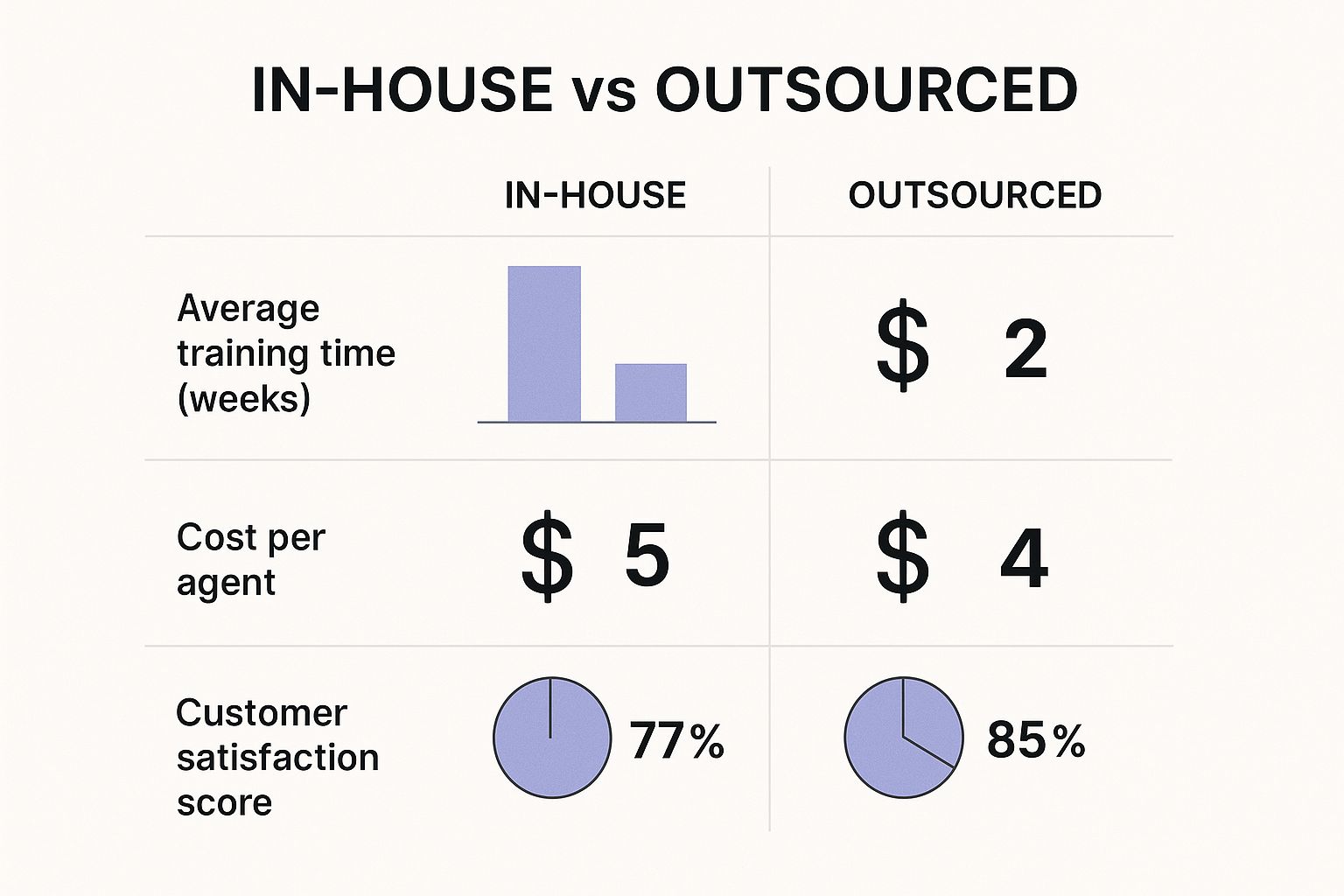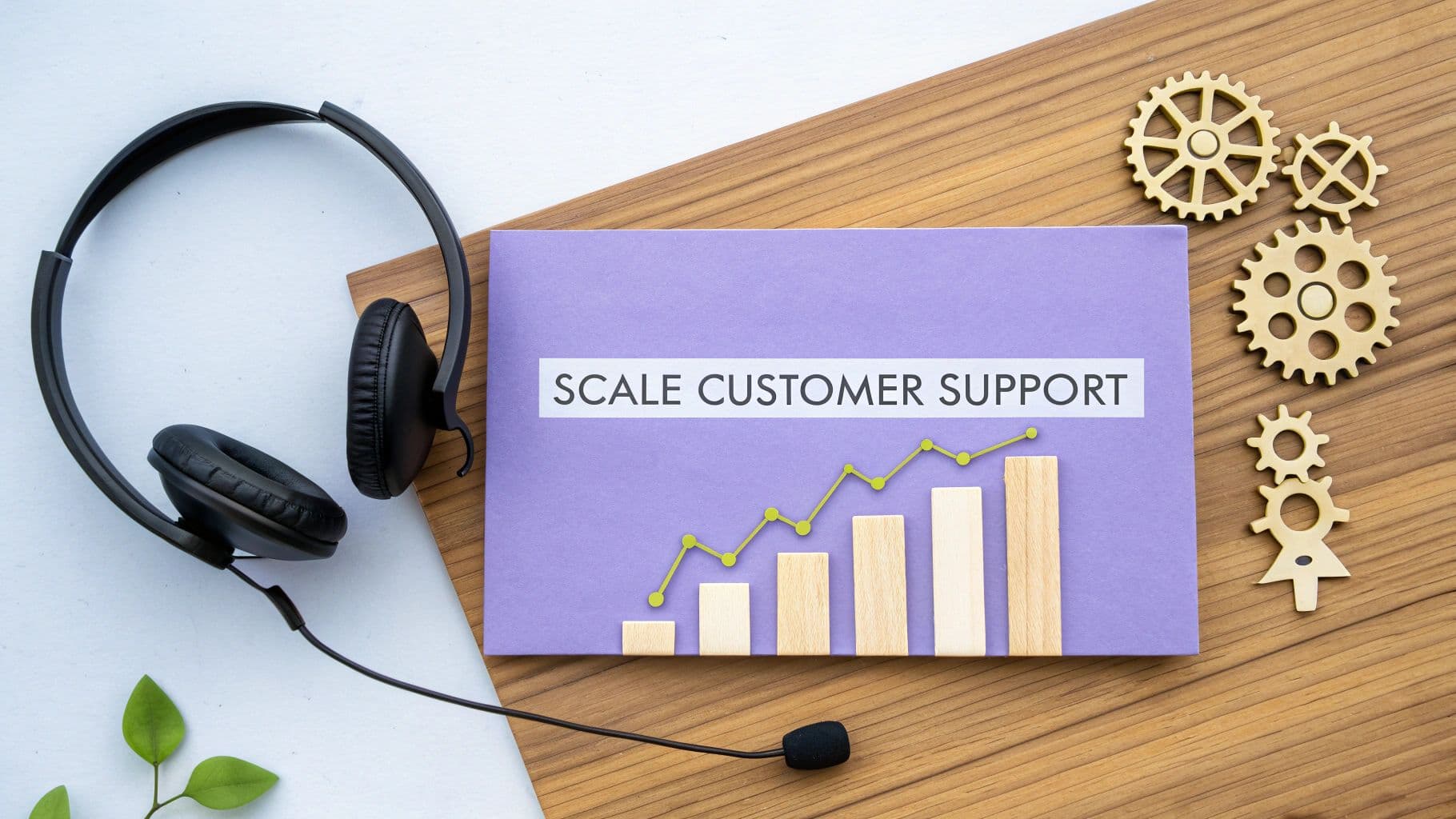Why Scaling Support Is Now Mission-Critical
Customer support has evolved. It's no longer just a necessary business function; it's a crucial driver of growth. In today's competitive landscape, providing exceptional customer experiences is key, and support plays a vital role in achieving this. This shift requires businesses to reconsider how they scale their support operations.
Leading companies are moving away from traditional staffing models. They're embracing new solutions to build more resilient support systems. This isn't just about keeping up with increasing customer demands; it's about turning customer support into a true strategic advantage.
The Changing Landscape of Customer Expectations
Customer expectations are always changing, shaped by the personalized experiences offered by leading brands. Consumers expect fast resolutions, personalized interactions, and 24/7 availability. This puts immense pressure on support teams, especially as companies grow. Relying on outdated support strategies can lead to longer wait times, frustrated customers, and ultimately, a loss of revenue.
This highlights the importance of a scalable support infrastructure that can adapt and change as needed.
The Business Impact of Scalable Support
The impact of inadequate support can be substantial. Poor support experiences can harm your brand's reputation, leading to customer churn and hindering your potential for growth. On the other hand, a well-scaled support system can boost customer loyalty, drive positive reviews, and increase customer lifetime value.
This means investing in scalable support isn't just a cost; it's an investment in the future success of your business. Scaling support can often begin with a simple online presence. You can explore creating one with platforms like WordPress.
Traditional Approaches vs. Strategic Scaling
Traditional staffing methods, where you simply hire more agents as your customer base expands, are often unsustainable and inefficient. This approach doesn't consider changes in demand and can result in higher costs without a corresponding improvement in customer satisfaction.
Strategic scaling, however, focuses on using technology and improving processes to create a more flexible and cost-effective support system. As customer expectations continue to increase, the global customer service software market is booming. In 2024, the market was valued at approximately $14.9 billion.
Projections show it will reach $68.19 billion by 2031, representing a CAGR of 20.94%. This growth highlights the importance of scalable customer support technology. Over 50% of businesses outsource customer service to boost efficiency and cut costs. More detailed statistics can be found here.
By adopting a strategic approach, businesses can build a support system that not only handles current demands but also anticipates and adapts to future growth.
Diagnosing Your Support Readiness

Before investing in scaling your customer support, it's essential to understand your current system's weaknesses. Simply throwing money at new technology or hiring more staff without a proper diagnosis can be expensive and ineffective. Just like a doctor diagnosing a patient, you need to identify the root cause of your support problems before implementing a solution. This section provides a framework for assessing your support readiness and highlighting areas for improvement.
Identifying Bottlenecks and Breaking Points
First, pinpoint the bottlenecks affecting your support operations. Are long wait times a consistent problem? Is your team swamped with a large number of repetitive questions? These are possible signs of a system struggling to keep up with demand. It's also critical to recognize early warning signs. For example, a spike in negative customer reviews or a decrease in customer satisfaction scores could indicate your team is nearing its breaking point.
This initial analysis helps you concentrate your scaling efforts where they'll have the most impact. Start by examining quantitative metrics such as average resolution time, first response time, and customer satisfaction scores (CSAT). However, metrics alone don't provide a complete understanding.
Gathering Qualitative Feedback for a Holistic View
Qualitative feedback adds valuable context and insights into the customer experience. This involves gathering information through surveys, customer interviews, and reviews to understand the reasons behind the numbers. Are customers unhappy with the self-service options? Do they feel their concerns aren't being addressed effectively? Combining quantitative metrics with qualitative feedback creates a comprehensive view of your support system.
For example, consider a company with a high average resolution time. The quantitative data highlights the issue, but qualitative feedback uncovers the underlying reason: agents lack access to the information they need, resulting in multiple follow-ups and delays. This deeper understanding allows you to avoid applying generic fixes and instead develop a targeted scaling strategy for your specific needs. It’s about selecting the correct tool for the task.
Utilizing a Support Scaling Framework
To structure the diagnostic process, consider using a framework like the one below. This table offers a structured approach to evaluating your current support capabilities and prioritizing scaling initiatives.
Support Scaling Readiness Assessment Framework
| Assessment Area | Key Metrics to Evaluate | Warning Signs | Scaling Readiness Indicators |
|---|---|---|---|
| Agent Performance | Resolution Time, First Response Time, CSAT | Declining CSAT, Increasing Agent Turnover | Consistently high CSAT, Low Turnover Rate |
| Channel Effectiveness | Volume per Channel, Resolution Time per Channel | High volume on inefficient channels | Optimized channel distribution, Low wait times |
| Self-Service Usage | Knowledge Base Article Views, Ticket Deflection Rate | Low usage of self-service resources, High ticket volume | High self-service usage, Low ticket volume |
| Technology | System Uptime, Integration Effectiveness | Frequent system outages, Difficulty sharing data | Seamless integrations, Reliable system performance |
This framework allows you to systematically evaluate key areas of your support operations. By understanding your strengths and weaknesses, you can identify areas for improvement and create a practical roadmap for scaling your customer support, ultimately achieving sustainable growth. Tools like FlowGent AI can then help you implement and manage these changes, enabling you to automate tasks, personalize customer interactions, and provide seamless support across various channels. Learn more about scaling support with AI on FlowGent.ai
The AI Revolution in Customer Support
Artificial intelligence is changing the game in customer support. It's not just about cutting costs anymore; it's about making the entire customer experience significantly better. Smart companies are using AI to tackle specific support challenges and boost their overall service quality. The key is understanding which support functions are best automated and which ones need that human touch.
Automating for Efficiency, Empowering for Complexity
AI shines when it comes to automating repetitive tasks. This frees up human agents to handle the more complicated stuff. For instance, AI-powered chatbots can instantly address frequently asked questions, give order updates, or guide customers through basic troubleshooting. This lets human agents concentrate on situations that require empathy, critical thinking, and personalized solutions. Think of it this way: AI handles the routine, while human agents become expert problem-solvers. This leads to a better, more efficient experience for everyone.
Integrating AI Seamlessly With Existing Systems
Scaling effectively with AI requires integrating these solutions with your current systems. This involves linking AI tools with your CRM, ticketing system, and knowledge base. This integration empowers the AI to use customer data, learn from past interactions, and deliver more personalized, context-relevant support. Training your team to work alongside AI tools is also critical. Agents must grasp the AI’s capabilities and limitations for seamless handoffs when human intervention is needed.
To illustrate the differences between in-house and outsourced support, the infographic below compares average training time, cost per agent, and customer satisfaction.

As the data shows, outsourced support can often reduce training time and cost per agent. However, maintaining high customer satisfaction requires careful selection and management of outsourced partners. Understanding these trade-offs is vital for making sound scaling decisions.
Setting Realistic Expectations and Measuring Performance
It's important to have realistic expectations for AI. It’s not a magic fix; it’s a tool that needs constant refinement and optimization. Customer support channels and technologies are changing rapidly, with AI at the forefront. By 2025, AI chatbot adoption is expected to increase by 34%, resolving almost 90% of inquiries in just a few messages. More than 90% of organizations using AI report considerable time and cost savings, with some reducing costs by up to 30%. For more detailed statistics, check out this resource.
Platforms like FlowGent AI provide powerful analytics to track important metrics, find areas for improvement, and ensure your AI strategy aligns with your business goals. This ongoing improvement is key to scaling customer support effectively. AI can analyze customer conversations to spot trends, pinpoint recurring issues, and deliver valuable data-driven insights to optimize your support operations.
The following table offers a comparison of various AI technologies and their applications in scaling customer support. It considers factors like ideal use cases, implementation difficulty, cost, and potential return on investment.
AI Implementation Comparison for Customer Support
| AI Technology Type | Best Use Cases | Implementation Complexity | Cost Considerations | Expected ROI |
|---|---|---|---|---|
| AI-powered Chatbots | Answering FAQs, providing order updates, basic troubleshooting | Low to Medium | Relatively low cost; ongoing maintenance required | High potential for cost reduction and increased efficiency |
| Natural Language Processing (NLP) | Sentiment analysis, understanding customer intent, personalized responses | Medium to High | Requires skilled personnel or specialized software | Improved customer satisfaction and personalized experiences |
| Machine Learning (ML) | Predictive analytics, personalized recommendations, automated ticket routing | High | Requires large datasets and expert knowledge | Improved efficiency and proactive support |
This table summarizes key factors to consider when choosing AI solutions for customer support. While chatbots offer a simpler entry point, NLP and ML can provide more advanced capabilities with a higher implementation complexity. Each technology holds unique benefits for enhancing customer support and driving positive business outcomes.
Crafting a Seamless Multi-Channel Experience

Today's customers expect consistent support, regardless of how they reach out. This means businesses need to develop a support system that operates smoothly across multiple channels. This approach creates a unified experience and strengthens brand identity. Let's explore how to build such a system.
Choosing the Right Channels for Your Customers
The first step in scaling customer support is selecting the right channels. Not all channels are created equal, and their effectiveness varies depending on the business. Consider your target audience and their communication preferences.
For example, younger demographics might prefer live chat or social media, while older customers might favor phone support. The complexity of your product or service also plays a role. A product with intricate features might benefit from video tutorials and detailed knowledge base articles.
Resource Allocation and Seamless Transitions
Effective resource allocation is essential for multi-channel success. Each channel requires different resources and expertise. Balance your resources according to customer demand and channel complexity.
Make sure your live chat is staffed during peak hours, and your email support team can handle complex inquiries. Smooth transitions between channels are also critical for a unified customer experience. If a customer starts on live chat and needs to switch to phone support, the transition should be seamless and preserve context. Think of it like a relay race – smooth handoffs are essential.
Scaling Individual Channels While Maintaining Integration
Each support channel presents unique scaling challenges. Email can be scaled through automation and templated responses. Live chat can be scaled using chatbots for initial interactions, while phone support might benefit from a tiered system with specialized agents. Social media support requires a different approach, focused on public communication and community management.
While scaling each channel individually is important, they must function as an integrated whole. A platform like FlowGent AI can help integrate these channels, creating an interconnected support ecosystem. This ensures customers receive consistent, high-quality support regardless of their chosen communication method. This integration is key for maintaining a consistent brand voice and preventing customers from falling through the cracks.
By connecting these channels, you build a cohesive and efficient support network that adapts to customer needs. This allows you to scale your customer support effectively while maximizing efficiency. Learn more about scaling support with AI on FlowGent.ai.
The Human Element in Scaled Support

As technology becomes increasingly crucial for customer support, the human element is more vital than ever. Finding the right balance between efficient automation and genuine human interaction is key. This balance is what elevates support from adequate to truly exceptional. This section explores how to maintain this essential human touch while scaling your support operations.
Identifying the Right Blend of Automation and Human Touch
Scaling customer support successfully depends on understanding where automation shines and where the human touch is indispensable. AI and automation are excellent for handling routine questions, providing quick responses to FAQs, and managing simple troubleshooting. AI and Automation free up human agents to address more complex problems, cultivate customer relationships, and deliver empathetic support.
For example, an AI chatbot can efficiently handle password resets. A human agent, however, is better suited to help a frustrated customer with a complicated technical problem.
This strategic approach to task allocation ensures efficiency while maintaining the personalized service that fosters customer loyalty. But the human element extends beyond customer interactions. Internal team dynamics and leadership also play a significant role. One startling statistic highlights the disconnect between technology investments and service outcomes. Despite substantial investments in AI, U.S. companies are losing an estimated $75 billion annually due to inadequate customer service as of 2025. More detailed statistics can be found here.
Training for Emotional Intelligence and Soft Skills
With AI handling routine tasks, human agents need to develop skills that set them apart. This requires investing in training that focuses on emotional intelligence, empathy, and strong communication skills. These soft skills are essential for building rapport with customers, de-escalating tense situations, and offering truly personalized support.
Training agents to actively listen, understand nonverbal cues, and respond with empathy can significantly boost customer satisfaction. Further, empowering agents to take ownership of customer issues and exceed expectations cultivates a sense of responsibility and builds stronger customer relationships. These skills allow agents to provide support that feels authentic and human, even within a large-scale operation.
Maintaining Consistency and Personalization at Scale
Maintaining a consistent brand voice and delivering personalized experiences can be challenging as your support team expands. This is where clear communication guidelines, well-defined procedures, and appropriate technology make a difference. Using a platform like FlowGent AI allows you to integrate various support channels and maintain a unified brand presence.
Moreover, FlowGent AI's agent profiles and knowledge base integrations enable personalized interactions and consistent support across every channel. This ensures every customer interaction aligns with your brand values and strengthens your overall brand identity, no matter the channel or the agent handling the request. Ultimately, scaling customer support is about blending the efficiency of technology with the impact of human connection to create an outstanding customer experience. Learn more about scaling customer support with FlowGent AI.
Building Self-Service That Customers Actually Use
Self-service support is essential for scaling customer support operations effectively. Simply having a knowledge base isn't enough. True success lies in creating resources that customers actively want to use. This involves understanding customer needs and developing content that directly addresses them. This section will guide you through building a truly effective self-service ecosystem.
Identifying Issues Best Suited for Self-Resolution
Not every support issue is a good fit for self-service. Begin by identifying common, easily resolved problems. These could include password resets, basic troubleshooting steps, or frequently asked questions (FAQs). These issues can often be addressed through clear, concise articles or video tutorials. This allows your support team to focus on more complex issues, boosting overall efficiency.
For example, a well-written article guiding customers through a password reset can drastically reduce the number of password reset requests your team handles. This simple change frees up valuable time and resources.
Creating Content That Addresses Customer Needs
Effective self-service content needs to be more than just informative; it needs to be easy to understand and act upon. Use clear, concise language, avoiding technical jargon. Organize information logically with headings, subheadings, and bullet points. Visuals like screenshots or short videos can help demonstrate more complex procedures. The goal is to make finding and understanding solutions as effortless as possible.
Instead of long, complicated explanations, focus on direct answers to specific questions. Think of it like a recipe: clear, step-by-step instructions make it easy for anyone to follow. This approach makes self-service more attractive and reduces the need for customers to directly contact support.
Designing Intuitive Navigation and Search Functionality
Even the best content is useless if customers can't find it. A well-designed self-service portal needs intuitive navigation and a robust search function. Organize your knowledge base into clear categories using descriptive titles for articles. Ensure your search function can handle misspellings and variations in phrasing. Easy access to information empowers customers to quickly find their own answers.
Think of your self-service portal like a library. A clear organization system and effective search catalog make it easy to find any book. This same principle applies to your self-service portal. A well-structured, searchable knowledge base empowers customers to find the solutions they need. Platforms like FlowGent AI can help build these systems and integrate them with your existing tools.
Exploring Different Self-Service Formats and Encouraging Adoption
Consider a variety of self-service formats beyond written articles. Video tutorials, interactive troubleshooting tools, and community forums can cater to different learning styles and preferences. Actively encourage customers to use these resources by prominently displaying them on your website and within your product.
Promoting self-service options through email newsletters and social media can also boost adoption. Consider gamification, like badges or points, to further incentivize usage. Measuring the impact of your self-service options is key for ongoing improvement. Track metrics like knowledge base article views, ticket deflection rate, and customer satisfaction with self-service. FlowGent AI's analytics dashboards can help monitor these key metrics and identify areas for optimization. This data-driven approach ensures your self-service resources stay relevant and effective as your customer base and product evolve. Use this feedback to refine your content, improve navigation, and expand your offerings to meet changing customer needs. By creating a robust, user-friendly self-service system, you can significantly scale your customer support and enhance the customer experience.
Measuring What Matters in Scaled Support
Scaling customer support effectively isn't simply about handling a larger volume of inquiries. It's about delivering better quality support while managing growth. This means focusing on the right performance indicators. Traditional metrics like average handle time and resolution time remain valuable, but they offer a limited perspective. For a true understanding of scaled support success, we need to look beyond these basic measures.
Developing a Comprehensive Measurement Framework
A comprehensive measurement framework provides a holistic view of your support performance. This framework should encompass efficiency, quality, and business impact. Efficiency metrics, such as cost per contact, help you track operational expenses. Quality indicators, like customer satisfaction (CSAT) and Net Promoter Score (NPS), offer insights into the customer experience. Finally, business impact metrics, including customer churn rate and customer lifetime value, demonstrate how support influences your bottom line.
For example, a reduced resolution time might appear positive. However, if this coincides with a drop in CSAT, it signals a potential issue. Customers might be receiving quicker responses, but perhaps not the helpful answers they need. This highlights the importance of a balanced measurement approach.
Setting Benchmarks and Analyzing Data
Effective measurement relies on relevant benchmarks. Compare your performance not only to industry averages and competitor data, but also to your own historical performance. Consider your company's growth stage and specific customer expectations when establishing benchmarks. A startup, for instance, will likely have different benchmarks than a well-established enterprise. This contextual understanding is critical for accurately evaluating performance.
Data analysis is essential for uncovering trends and understanding the factors driving your results. Tools like FlowGent AI provide robust analytics dashboards to track key metrics, identify patterns, and perform root cause analysis of recurring problems. This facilitates targeted improvements, leading to more efficient and effective support.
Prioritizing Improvements for Sustainable Scaling
Prioritizing improvements is crucial for optimizing resource allocation. Focus on changes that will have the greatest impact on your ability to scale customer support sustainably. For instance, if your analysis reveals a high volume of support tickets related to simple questions, improving self-service resources becomes a high priority. This might involve expanding your knowledge base or creating interactive troubleshooting tools.
By identifying and addressing these bottlenecks, you can streamline your operations and free up your team to handle more complex customer issues. This targeted approach ensures that your scaling efforts deliver the highest return on investment. Want to scale your customer support efficiently and effectively? Learn more about how FlowGent AI can help.



